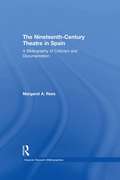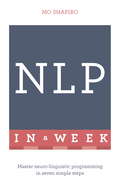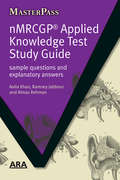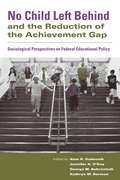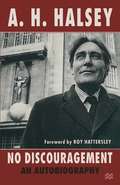- Table View
- List View
The Nine Pillars of Great Schools
by Damian McBeath David Woods Rachel MacfarlaneWhat makes a school great? Studies into good schools are numerous, but there has been much less written about great schools. The former are more common, but with success comes complacency; good is the enemy of great. In 2009 the London Leadership Strategy established the Going for Great programme, creating a forum for leaders of schools rated `outstanding' by Ofsted. This collaboration sought to identify and share best practice; based on their case studies, school-to-school visits, the research literature and through seminar, debates and discussions, a model of great schooling has emerged.This publication seeks to explore in depth the Nine Pillars of Greatness written by the course leaders of the Going for Great programme. It considers the range of characteristics that define great schooling, from a school's values and ethos, leadership and teaching to its curriculum, approach to professional development, learning community and ongoing self-evaluation.Supported by a wealth of academic pedagogical texts and written by three authors who have spent their lives in education, The Nine Pillars of Great Schools examines the commonalities between the most successful institutions and demonstrates how to transform a good school into a great school.
The Nine Types of Leader: How the Leaders of Tomorrow Can Learn from The Leaders of Today
by James AshtonFind out what makes great leaders tick, learn what it takes to be credible and read about the things that they'd do differently if they had to do it all again. The Nine Types of Leader introduces some obvious and some not so obvious types of leader through stories, anecdotes and insight garnered from hundreds of encounters with world-class leaders. Featuring interviews with industry titans including Jean-Francois Decaux of JC Decaux, Michael Rapino of Live Nation, Zhang Ruimin of Haier, Gavin Patterson of Salesforce and Isabelle Kocher of Engie, it explores how the leaders of tomorrow will improve their game by borrowing from the very best of the nine types of leader that exist today.Renowned journalist, James Ashton assesses the strengths and weaknesses of each leadership type, highlighting where and when they are best deployed, whilst helping you identify who you are and how you can improve performance. As the world seeks to recover from drastic disruption and uncertainty and the most acute test of leadership in living memory, it projects how future leaders can learn from what has gone before.
Nine Years Old
by M. PollakIn 1972, Dr Margaret Pollak published her book Today's Three-Year Oids in London. This was a sensitive study of family life and the social environment of a large number of London children, together with an account of their developmental assessment by various test methods. She showed that variations of developmental performances were more closely related to the quality of family life than to social and economic factors. Dr Pollak has now re-investigated the same children at nine years of age and this book is a record of her findings. The differences in development which were noted at three years of age remain in the older children. Those children who, at three years of age, were underachievers, particularly in verbal and adaptive abilities, are the children who, at nine years, can still be identified by lower achieve ment at school. These results must be of important relevance to educationalists, and all concerned with the psychologists as well as to paediatricians welfare of children. We must all be disturbed by the failure of any children in our urban city centres to benefit from education and our anxieties must be heightened if, amongst the underachievers, there are particular groups who can be identified by their ethnic identities. In Britain, education in school occupies a relatively small part of a child's life. Dr Pollak has identified some of the factors in a child's wider experience and, especially, in the total home environment which are associated with the persistence of inferior performance.
The Nineteenth-Century Theatre in Spain: A Bibliography of Criticism and Documentation
by Margaret A ReesFirst Published in 2002. The present volume forms part of a major Bibliography of the Hispanic Theatre, forthcoming in several volumes by different specialists. As such, it is one of the products of a still larger computer-assisted Project of Hispanic Research Bibliographies. The aim has been to give as wide a coverage to the area as possible, listing not only books and articles in periodicals but also data of a documentary character such as items on playbills and the local regulation of theatres. Annotation is confined to information, and critical appraisal is excluded.
The Nineteenth-Century Theatre in Spain: A Bibliography of Criticism and Documentation
by Margaret A ReesFirst Published in 2002. The present volume forms part of a major Bibliography of the Hispanic Theatre, forthcoming in several volumes by different specialists. As such, it is one of the products of a still larger computer-assisted Project of Hispanic Research Bibliographies. The aim has been to give as wide a coverage to the area as possible, listing not only books and articles in periodicals but also data of a documentary character such as items on playbills and the local regulation of theatres. Annotation is confined to information, and critical appraisal is excluded.
Nineteenth-century women illustrators and cartoonists
by Jo DevereuxNineteenth-century women illustrators and cartoonists provides an in-depth analysis of fifteen women illustrators of the later nineteenth and early twentieth centuries: Jemima Blackburn, Eleanor Vere Boyle, Marianne North, Amelia Francis Howard-Gibbon, Mary Ellen Edwards, Edith Hume, Alice Barber Stephens, Florence and Adelaide Claxton, Marie Duval, Amy Sawyer, Eleanor Fortescue Brickdale, Pamela Colman Smith and Olive Allen Biller. The chapters consider these women’s illustrations in the areas of natural history, periodicals and books, as well as their cartoons and caricatures. Using diverse critical approaches, the volume brings to light the works and lives of these important women illustrators and challenges the hegemony of male illustrators and cartoonists in nineteenth-century visual and print culture.
Nineteenth-century women illustrators and cartoonists
by Joanna DevereuxNineteenth-century women illustrators and cartoonists provides an in-depth analysis of fifteen women illustrators of the later nineteenth and early twentieth centuries: Jemima Blackburn, Eleanor Vere Boyle, Marianne North, Amelia Francis Howard-Gibbon, Mary Ellen Edwards, Edith Hume, Alice Barber Stephens, Florence and Adelaide Claxton, Marie Duval, Amy Sawyer, Eleanor Fortescue Brickdale, Pamela Colman Smith and Olive Allen Biller. The chapters consider these women’s illustrations in the areas of natural history, periodicals and books, as well as their cartoons and caricatures. Using diverse critical approaches, the volume brings to light the works and lives of these important women illustrators and challenges the hegemony of male illustrators and cartoonists in nineteenth-century visual and print culture.
Nip It! Dig It!: Phase 2 (Big Cat Phonics For Little Wandle Letters And Sounds Revised Ser.)
by Natasha Paul Collins Big CatCollins Big Cat Phonics for Letters and Sounds features exciting fiction and non-fiction decodable readers to enthuse and inspire children. They are fully aligned to Letters and Sounds Phases 1-6 and contain notes in the back. The Handbooks provide support in demonstration and modelling, monitoring comprehension and expanding vocabulary. Ever wondered what rabbits do during the day? Find out in this photographic non-fiction book. Pink B/Band 1B offers emergent readers simple, predictable text with familiar objects and actions. The focus sounds in this book are: /g/ /o/ Pages 14 and 15 contain a fun "I Spy" Letters and Sounds activity, which uses visual support to help children embed phonic knowledge. Reading notes within the book provide practical support for reading Big Cat Phonics for Letters and Sounds with children, including a list of all the sounds and words that the book will cover.
Niteracy Hour
by John DoughertyWHAT A LOUSE! Jim is a head-louse, newly-hatched from a nit on Gregory's head. But as Gregory is a good listener and it's 'in his blood', Jim's breakfast turns him into a good listener too and suddenly school storytime changes from Literacy Hour to Niteracy Hour. And can Jim help Gregory do something about Duncan, the class bully? He's the real louse in the class-
NIV Bible Handbook
by Alister McGrathWritten by Alister McGrath, one of Britain's most admired and insightful biblical scholars, the NIV Bible Handbook is designed to be read alongside the New International Version as a comprehensive guide to Scripture. McGrath's in-depth commentary is complemented by introductions to and outlines of every Bible book, explaining the authorship, context and purpose with which each book was written. The commentary is interspersed with over sixty feature articles addressing difficult questions arising from the Bible, such as, 'What does the Bible say about homosexuality?' and 'Did God really command all that killing?' A number of helpful maps and charts also aid appreciation of biblical narrative and history.
Niveauangemessenes Arbeiten in selbstdifferenzierenden Lernumgebungen: Eine qualitative Fallstudie am Beispiel einer Würfelnetz-Lernumgebung (Dortmunder Beiträge zur Entwicklung und Erforschung des Mathematikunterrichts #12)
by Christine ScherresSelbstdifferenzierende Lernumgebungen versprechen ein umfassendes Differenzierungspotenzial. Christine Scherres erfasst dieses Potenzial nicht wie üblich durch Niveaustreuung, sondern auch durch Niveauangemessenheit. Denn für die Wirksamkeit von Lernen ist niveauangemessenes Arbeiten wichtig. Für ihre Fallstudie konstruiert sie ein analytisches Instrumentarium zur Untersuchung der Niveauangemessenheit aus prozessorientierter Perspektive. Sie zeigt, dass sich Niveauangemessenheit einer selbstdifferenzierenden Würfelnetz-Lernumgebung keineswegs automatisch einstellt, sondern einer Unterstützung durch unterrichtliche Kontextbedingungen bedarf.
NL ARMS Netherlands Annual Review of Military Studies 2019: Educating Officers: The Thinking Soldier - The NLDA and the Bologna Declaration (NL ARMS)
by Wim Klinkert Myriame Bollen Marenne Jansen Henk De Jong Eric-Hans Kramer Lisette VosThis book has as its subject matter the academic education of officers and builds on the signing of the Bologna Declaration in 1999 by twenty-nine European ministers for Education and Science, who thereby agreed to coordinate higher education across Europe, by, for instance, the implementation of the Bachelor's and Master's system. In the meantime, military academies have also introduced the BaMa system into their programs for officers’ education, which marks a transition from the old days, when officers’ education took place within a national military system, under military command, and was firmly grounded in principles, traditions and needs, as professed by the Ministries of Defence and the armed forces in particular. So the Bologna Declaration can be seen as crucial leverage for the development of in-house academic degree programs as a fundamental part of officers’ education. With this volume, the editors of NL ARMS 2019 strive to offer a platform to both academics and military and civilian practitioners, as well as to combinations of these, to reflect and share their thoughts on officers’ education `before and after' Bologna, both in The Netherlands and abroad. To this end, controversies and challenges, affecting various aspects and systems of officers’ education, have been grouped into five themes. Respectively, the first four themes comprise institutional settings and change; educational philosophy; educational challenges and reflective practices; and didactical solutions. The fifth theme, international perspectives, provides insights into the strategic environments and challenges faced by sister-academies, as well as ways to further officers' education across Europe, such as offered by Erasmus programs. All the editors of this year's volume are affiliated with the Faculty of Military Sciences of the Netherlands Defence Academy in Breda, The Netherlands.
NLD from the Inside Out: Talking to Parents, Teachers, and Teens about Growing Up with Nonverbal Learning Disabilities - Third Edition
by Michael Brian MurphyOffering invaluable advice for teenagers and young adults with Nonverbal Learning Disabilities (NLD), this book explains what NLD is, how to understand your NLD brain, and how to thrive socially and academically with an NLD. The book also includes guidance for parents, teachers and therapists on the issues that people with NLD want them to know.
NLP Coaching: An Evidence-Based Approach for Coaches, Leaders and Individuals
by Dr Susie Linder-PelzNLP (Neuro-Linguistic Programming) is believed by many to be a powerful set of tools for facilitating change and enhancing performance. Yet, despite the success stories and proliferation of courses, there is still much skepticism about the validity and effectiveness of NLP.In NLP Coaching Susie Linder-Pelz brings, for the first time, an evidence-based perspective to this coaching methodology. She explains how and where NLP coaching is used, examines its links to established principles and practices, and questions aspects of NLP where the empirical evidence is missing. She reviews recent developments in NLP-based coaching practice and proposes a specific research agenda that will move NLP coaching towards an evidence-based approach.NLP Coaching provides numerous case studies and real-life examples which show how NLP assists personal, professional, team, leadership and organizational development. The book includes contributions from leaders in the field: Andrew Bryant, Michelle Duval, Joseph O'Connor, Paul Tosey and Lisa Wake.
NLP Coaching: An Evidence-Based Approach for Coaches, Leaders and Individuals
by Dr Susie Linder-PelzNLP (Neuro-Linguistic Programming) is believed by many to be a powerful set of tools for facilitating change and enhancing performance. Yet, despite the success stories and proliferation of courses, there is still much skepticism about the validity and effectiveness of NLP.In NLP Coaching Susie Linder-Pelz brings, for the first time, an evidence-based perspective to this coaching methodology. She explains how and where NLP coaching is used, examines its links to established principles and practices, and questions aspects of NLP where the empirical evidence is missing. She reviews recent developments in NLP-based coaching practice and proposes a specific research agenda that will move NLP coaching towards an evidence-based approach.NLP Coaching provides numerous case studies and real-life examples which show how NLP assists personal, professional, team, leadership and organizational development. The book includes contributions from leaders in the field: Andrew Bryant, Michelle Duval, Joseph O'Connor, Paul Tosey and Lisa Wake.
NLP In A Week: Master Neuro-Linguistic Programming In Seven Simple Steps (TYW)
by Mo ShapiroNLP In A Week is a simple and straightforward guide to neuro-linguistic programming, giving you everything you need to know in just seven short chapters. From communicating more effectively to creating greater rapport with others, you'll discover the ability to change what isn't working in your life and increase what is.This book introduces you to the main themes and ideas of NLP, giving you a basic knowledge and understanding of the key concepts, together with practical and thought-provoking exercises. Whether you choose to read it in a week or in a single sitting, NLP In A Week is your fastest route to success:- Sunday: What is neuro-linguistic programming?- Monday: Identify empowering and limiting beliefs- Tuesday: Recognize how we represent information to ourselves- Wednesday: Use precision questions to find out what people mean- Thursday: Identify different communication filters- Friday: Use the six levels of change and reframing- Saturday: Increase your optionsABOUT THE SERIESIn A Week books are for managers, leaders, and business executives who want to succeed at work. From negotiating and content marketing to finance and social media, the In A Week series covers the business topics that really matter and that will help you make a difference today. Written in straightforward English, each book is structured as a seven-day course so that with just a little work each day, you will quickly master the subject. In a fast-changing world, this series enables readers not just to get up to speed, but to get ahead.
NMRCGP Applied Knowledge Test Study Guide: Sample Questions and Explanatory Answers
by Aalia Khan Ramsey Jabbour Almas RehmanAs three young, dynamic GPs working in London we realised that there was a dearth of well written up-to-date MCQ revision guides with satisfactory explanations. Since we all achieved distinctions in the MRCGP exam we believed we could incorporate our revision notes on hot topics to develop a high-quality contemporary MCQ resource...This comprehensive revision aid covers the entire nMRCGP syllabus over four exam papers. It's the most up-to-date guide available for the new exam and, alongside its online resources, provides a wide-ranging tool for candidates. It's easy to read and comprehend, and exam topics are grouped in the index to make for easy reference and further study.
NMRCGP Applied Knowledge Test Study Guide: Sample Questions and Explanatory Answers
by Aalia Khan Ramsey Jabbour Almas RehmanAs three young, dynamic GPs working in London we realised that there was a dearth of well written up-to-date MCQ revision guides with satisfactory explanations. Since we all achieved distinctions in the MRCGP exam we believed we could incorporate our revision notes on hot topics to develop a high-quality contemporary MCQ resource...This comprehensive revision aid covers the entire nMRCGP syllabus over four exam papers. It's the most up-to-date guide available for the new exam and, alongside its online resources, provides a wide-ranging tool for candidates. It's easy to read and comprehend, and exam topics are grouped in the index to make for easy reference and further study.
No Child Left Behind and the Public Schools
by Scott Abernathy“A powerful, detailed, and exceptionally balanced critique of NCLB. It offers some hope for how we might overcome its faults. No legislator or educational expert should be allowed to get away with not reading it—whether to agree or disagree. It’s a must learning experience.” —Deborah Meier, Senior Scholar and Adjunct Professor, Steinhardt School of Education, New York University, and author of In Schools We Trust “A concise, highly readable, and balanced account of NCLB, with insightful and realistic suggestions for reform. Teachers, professors, policymakers, and parents—this is the one book about NCLB you ought to read.” —James E. Ryan, William L. Matheson and Robert M. Morgenthau Distinguished Professor, University of Virginia School of Law This far-reaching new study looks at the successes and failures of one of the most ambitious and controversial educational initiatives since desegregation—the No Child Left Behind Act of 2001. NCLB’s opponents criticize it as underfunded and unworkable, while supporters see it as a radical but necessary educational reform that evens the score between advantaged and disadvantaged students. Yet the most basic and important question remains unasked: “Can we ever really know if a child’s education is good?” Ultimately, Scott Franklin Abernathy argues, policymakers must begin from this question, rather than assuming that any test can accurately measure the elusive thing we call “good” education.
No Child Left Behind and the Reduction of the Achievement Gap: Sociological Perspectives on Federal Educational Policy
by Alan R. Sadovnik Jennifer A. O’Day George W. Bohrnstedt Kathryn M. BormanThis monumental collection presents the first-ever sociological analysis of the No Child Left Behind Act and its effects on children, teachers, parents, and schools. More importantly, these leading sociologists consider whether NLCB can or will accomplish its major goal: to eliminate the achievement gap by 2014. Based on theoretical and empirical research, the essays examine the history of federal educational policy and place NCLB in a larger sociological and historical context. Taking up a number of policy areas affected by the law—including accountability and assessment, curriculum and instruction, teacher quality, parental involvement, school choice and urban education—this book examines the effects of NCLB on different groups of students and schools and the ways in which school organization and structure affect achievement. No Child Left Behind concludes with a discussion of the important contributions of sociological research and sociological analysis integral to understanding the limits and possibilities of the law to reduce the achievement gap.
No Child Left Behind and the Reduction of the Achievement Gap: Sociological Perspectives on Federal Educational Policy
by Alan R. Sadovnik Jennifer A. O'Day George W. Bohrnstedt Kathryn M. BormanThis monumental collection presents the first-ever sociological analysis of the No Child Left Behind Act and its effects on children, teachers, parents, and schools. More importantly, these leading sociologists consider whether NLCB can or will accomplish its major goal: to eliminate the achievement gap by 2014. Based on theoretical and empirical research, the essays examine the history of federal educational policy and place NCLB in a larger sociological and historical context. Taking up a number of policy areas affected by the law—including accountability and assessment, curriculum and instruction, teacher quality, parental involvement, school choice and urban education—this book examines the effects of NCLB on different groups of students and schools and the ways in which school organization and structure affect achievement. No Child Left Behind concludes with a discussion of the important contributions of sociological research and sociological analysis integral to understanding the limits and possibilities of the law to reduce the achievement gap.
No Citizen Left Behind (Educational psychology: critical pedagogical perspectives ; #13)
by Meira LevinsonWhile teaching at an all-Black middle school in Atlanta, Levinson realized that her students’ individual self-improvement would not necessarily enable them to overcome their historical marginalization. In order to overcome their civic empowerment gap, students must learn how to reshape power relationships through public political and civic action.
No Citizen Left Behind (Educational psychology: critical pedagogical perspectives ; #13)
by Meira LevinsonWhile teaching at an all-Black middle school in Atlanta, Levinson realized that her students’ individual self-improvement would not necessarily enable them to overcome their historical marginalization. In order to overcome their civic empowerment gap, students must learn how to reshape power relationships through public political and civic action.
No Discouragement: An Autobiography
by A.H. Halsey foreword Roy HattersleyThis is the autobiography of a working-class boy who became an Oxford professor. A.H. Halsey was born in Kentish Town, London, in 1923 - a railway child in a large clan. The family moved in 1926 to Rutland and then to Northamptonshire because the father had been wounded in the Great War. Halsey 'won the scholarship' to Kettering Grammar School in 1933, left school at 16, went into the RAF as a pilot cadet. The metaphor of travel through time and space is maintained throughout this autobiography. The story begins with daily walks past canal boats in Oxford, flashes to the Pacific to Hong Kong and China, and then to a glimpse of death in the John Radcliffe Hospital, promising to explain the whole journey from a council housing estate to a professorial chair at Oxford.



